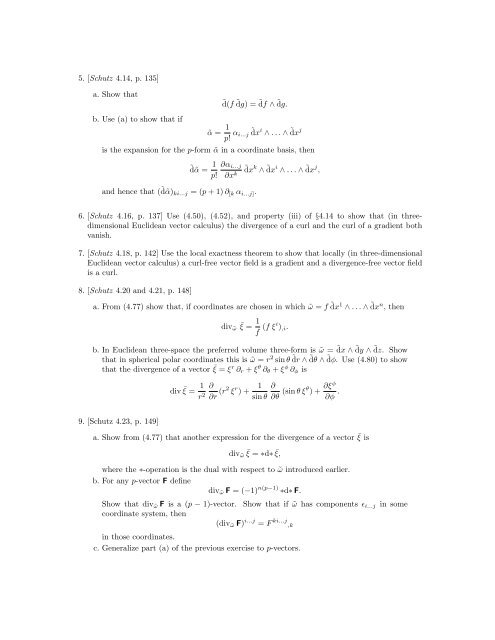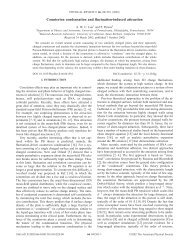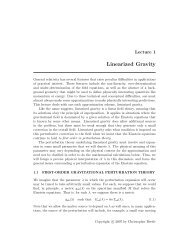Differential Geometry Exercises I: Tensors - Fau.edu
Differential Geometry Exercises I: Tensors - Fau.edu
Differential Geometry Exercises I: Tensors - Fau.edu
You also want an ePaper? Increase the reach of your titles
YUMPU automatically turns print PDFs into web optimized ePapers that Google loves.
5. [Schutz 4.14, p. 135]<br />
a. Show that<br />
b. Use (a) to show that if<br />
˜d(f ˜dg) = ˜df ∧ ˜dg.<br />
˜α = 1 p! α i...j ˜dx i ∧ . . . ∧ ˜dx j<br />
is the expansion for the p-form ˜α in a coordinate basis, then<br />
˜d˜α = 1 p!<br />
∂α i...j<br />
∂x k ˜dx k ∧ ˜dx i ∧ . . . ∧ ˜dx j ,<br />
and hence that (˜d˜α) ki...j = (p + 1) ∂ [k α i...j] .<br />
6. [Schutz 4.16, p. 137] Use (4.50), (4.52), and property (iii) of §4.14 to show that (in threedimensional<br />
Euclidean vector calculus) the divergence of a curl and the curl of a gradient both<br />
vanish.<br />
7. [Schutz 4.18, p. 142] Use the local exactness theorem to show that locally (in three-dimensional<br />
Euclidean vector calculus) a curl-free vector field is a gradient and a divergence-free vector field<br />
is a curl.<br />
8. [Schutz 4.20 and 4.21, p. 148]<br />
a. From (4.77) show that, if coordinates are chosen in which ˜ω = f ˜dx 1 ∧ . . . ∧ ˜dx n , then<br />
div˜ω ¯ξ =<br />
1<br />
f (f ξi ) ,i .<br />
b. In Euclidean three-space the preferred volume three-form is ˜ω = ˜dx ∧ ˜dy ∧ ˜dz. Show<br />
that in spherical polar coordinates this is ˜ω = r 2 sin θ ˜dr ∧ ˜dθ ∧ ˜dφ. Use (4.80) to show<br />
that the divergence of a vector ¯ξ = ξ r ∂ r + ξ θ ∂ θ + ξ φ ∂ φ is<br />
div ¯ξ = 1 ∂<br />
r 2 ∂r (r2 ξ r ) + 1 ∂<br />
sin θ ∂θ (sin θ ξθ ) + ∂ξφ<br />
∂φ .<br />
9. [Schutz 4.23, p. 149]<br />
a. Show from (4.77) that another expression for the divergence of a vector ¯ξ is<br />
div˜ω ¯ξ = ∗d∗ ¯ξ,<br />
where the ∗-operation is the dual with respect to ˜ω introduced earlier.<br />
b. For any p-vector F define<br />
div˜ω F = (−1) n(p−1) ∗d∗ F.<br />
Show that div˜ω F is a (p − 1)-vector. Show that if ˜ω has components ɛ i...j in some<br />
coordinate system, then<br />
(div˜ω F) i...j = F ki...j ,k<br />
in those coordinates.<br />
c. Generalize part (a) of the previous exercise to p-vectors.






